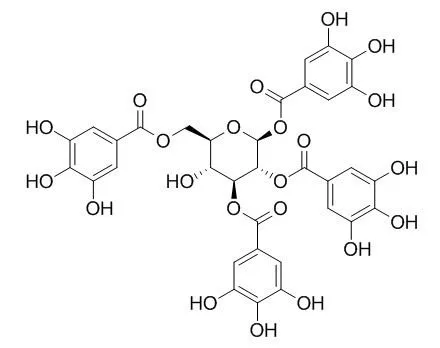| In vitro: |
| Biosci Biotechnol Biochem. 2008 Aug;72(8):2158-63. | | Antioxidative activities of galloyl glucopyranosides from the stem-bark of Juglans mandshurica.[Pubmed: 18685223] |
METHODS AND RESULTS:
Two phenolics, 1,2,6-trigalloylglucose (1) and 1,2,3,6-Tetragalloylglucose (2), isolated from the stem-bark of Juglans mandshurica were evaluated for their antioxidative activities. The results showed that compounds 1 and 1,2,3,6-Tetragalloylglucose exhibited strong scavenging activities against 1,1'-diphenyl-1-picrylhydrazyl (DPPH), 2,2'-azino-bis-(3-ethylbenzenthiazoline-6-sulphonic) acid (ABTS(*+)), and superoxide radicals (O(2)(*-)), and also had a significant inhibitory effect on lipid peroxidation and low-density lipoprotein (LDL) oxidation.
CONCLUSIONS:
The strong superoxide radical scavenging of 1 and 1,2,3,6-Tetragalloylglucose resulted from the potential competitive inhibition with xanthine at the active site of xanthine oxidase (OX). In addition, compounds 1 and 1,2,3,6-Tetragalloylglucose displayed significant lipoxygenase inhibitory activity, the mode of inhibition also being identified as competitive. In comparison, the antioxidative activities of compounds 1 and 1,2,3,6-Tetragalloylglucose, together with gallic acid, indicated that the number of galloyl moieties could play an important role in the antioxidative activity. | | Biol Pharm Bull. 2003 Jul;26(7):1042-4. | | Anti-complement activity of constituents from the stem-bark of Juglans mandshurica.[Pubmed: 12843637 ] |
METHODS AND RESULTS:
Four known flavonoids and two galloyl glucoses isolated from the stem-bark of Juglans mandshurica (Juglandaceae), namely taxifolin (1), afzelin (2), quercitrin (3), myricitrin (4), 1,2,6-trigalloylglucose (5), and 1,2,3,6-Tetragalloylglucose (6), were evaluated for their anti-complement activity against complement system. Afzelin (2) and quercitrin (3) showed inhibitory activity against complement system with 50% inhibitory concentrations (IC(50)) values of 258 and 440 microM. 1,2,6-Trigalloylglucose (5) and 1,2,3,6-Tetragalloylglucose (6) exhibited anti-complement activity with IC(50) values of 136 and 34 microM. In terms of the evaluation of the structure-activity relationship of 3,5,7-trihydroxyflavone, compounds 2, 3, and 4 were hydrolyzed with naringinase to give kaempferol (2a), quercetin (3a), and myricetin (4a) as their aglycones, and these were also tested for their anti-complement activity. Of the three aglycones, kaempferol (2a) exhibited weak anti-complement activity with an IC(50) value of 730 microM, while quercetin (3a) and myricetin (4a) were inactive in this assay system.
CONCLUSIONS:
Among the compounds tested, 1,2,3,6-Tetragalloylglucose (6) showed the most potent anticomplement activity (IC(50), 34 microM). | | Hum Exp Toxicol. 2011 Sep;30(9):1415-9. | | Inhibition effects of the classical pathway complement of isolated compounds from Quercus glauca.[Pubmed: 21078772] | Species of the Quercus species is an evergreen broadleaf tree found not only in Korea but also in China, Taiwan, and Japan. Quercus species is the most commonly occurring plant among the 50 native species of the family Fagaceae in Korea, China, and Taiwan. Quercus species have been used for diarrhea, dysentery, dermatitis, and hemorrhagia in Korean folk medicine. The present study evaluated the anticomplement effect of constituents from Quercus species (Fagaceae) in classical pathway complement system.
METHODS AND RESULTS:
We have evaluated leaves of five species of the Quercus genus with regard to its anticomplement activity and have identified its active principles following activity-guided isolation. Bioactivity-guided fractionation of the 80% methanol extracts of the stem barks of Quercus glauca Thunberg has led to the isolation of galloyl derivatives, displaying high anticomplement activity. Four galloyl derivatives isolated from the leaves of Q. glauca, namely 6'-O-galloyl salidroside (1), methyl gallate (2), 1,2,3,6-Tetragalloylglucose (3), and 1,2,6-trigalloylglucose (4). 1, 2, 3 and 4 showed inhibitory activity against complement system with 50% inhibitory concentrations (IC(50)) values of 224 μM, 362.4 μM, 32.3 μM, and 138.3 μM.
CONCLUSIONS:
Among the compounds tested, 3 showed the most potent anticomplement activity (IC(50), 32.3 μM). This is the first report of the isolation and anticomplement activity from Q. glauca. |
|
| In vivo: |
| Food Chem Toxicol . 2018 Oct;120:651-661. | | Identification and characterization of in vitro inhibitors against UDP-glucuronosyltransferase 1A1 in uva-ursi extracts and evaluation of in vivo uva-ursi-drug interactions[Pubmed: 30075316] | | Abstract
Uva-ursi leaf is widely used to treat symptoms of lower urinary tract infections. Here, we evaluated the in vitro inhibitory effects of uva-ursi extracts on 10 major human UDP-glucuronosyltransferases (UGT) isoforms. Of the 10 tested UGT isoforms, uva-ursi extracts exerted the strongest inhibitory effect on UGT1A1-mediated β-estradiol 3-glucuronidation with the lowest IC50 value of 8.45 ± 1.56 μg/mL. To identify the components of uva-ursi extracts showing strong inhibitory effects against UGT1A1, the inhibitory effects of nine major constituents of the extracts were assessed. Among the tested compounds, gallotannin exerted the most potent inhibition on UGT1A1, followed by 1,2,3,6-Tetragalloylglucose; both demonstrated competitive inhibition, with Ki values of 1.68 ± 0.150 μM and 3.55 ± 0.418 μM. We found that gallotannin and 1,2,3,6-Tetragalloylglucose also inhibited another UGT1A1-specific biotransformation, SN-38-glucuronidation, showing the same order of inhibition. Thus, in vitro UGT1A1 inhibitory potentials of uva-ursi extracts might primarily result from the inhibitory activities of gallotannin and 1,2,3,6-Tetragalloylglucose present in the extracts. However, in rats, co-administration with uva-ursi extracts did not alter the in vivo marker for UGT1A1 activity, expressed as the molar ratio of AUCSN-38 glucuronide/AUCSN-38, because plasma concentrations of gallotannin and 1,2,3,6-Tetragalloylglucose may be too low to inhibit the UGT1A1-mediated metabolism of SN-38 in vivo. The poor oral absorption of gallotannin and 1,2,3,6-Tetragalloylglucose in uva-ursi extracts might cause the poor in vitro-in vivo correlation. These findings will be helpful for the safe and effective use of uva-ursi extracts in clinical practice.
Keywords: 1,2,3,6-Tetragalloylglucose; Gallotannin; In vitro UGT1A1 inhibition; In vivo herb‒drug interaction; Uva-ursi extract. |
|






 Cell. 2018 Jan 11;172(1-2):249-261.e12. doi: 10.1016/j.cell.2017.12.019.IF=36.216(2019)
Cell. 2018 Jan 11;172(1-2):249-261.e12. doi: 10.1016/j.cell.2017.12.019.IF=36.216(2019) Cell Metab. 2020 Mar 3;31(3):534-548.e5. doi: 10.1016/j.cmet.2020.01.002.IF=22.415(2019)
Cell Metab. 2020 Mar 3;31(3):534-548.e5. doi: 10.1016/j.cmet.2020.01.002.IF=22.415(2019) Mol Cell. 2017 Nov 16;68(4):673-685.e6. doi: 10.1016/j.molcel.2017.10.022.IF=14.548(2019)
Mol Cell. 2017 Nov 16;68(4):673-685.e6. doi: 10.1016/j.molcel.2017.10.022.IF=14.548(2019)